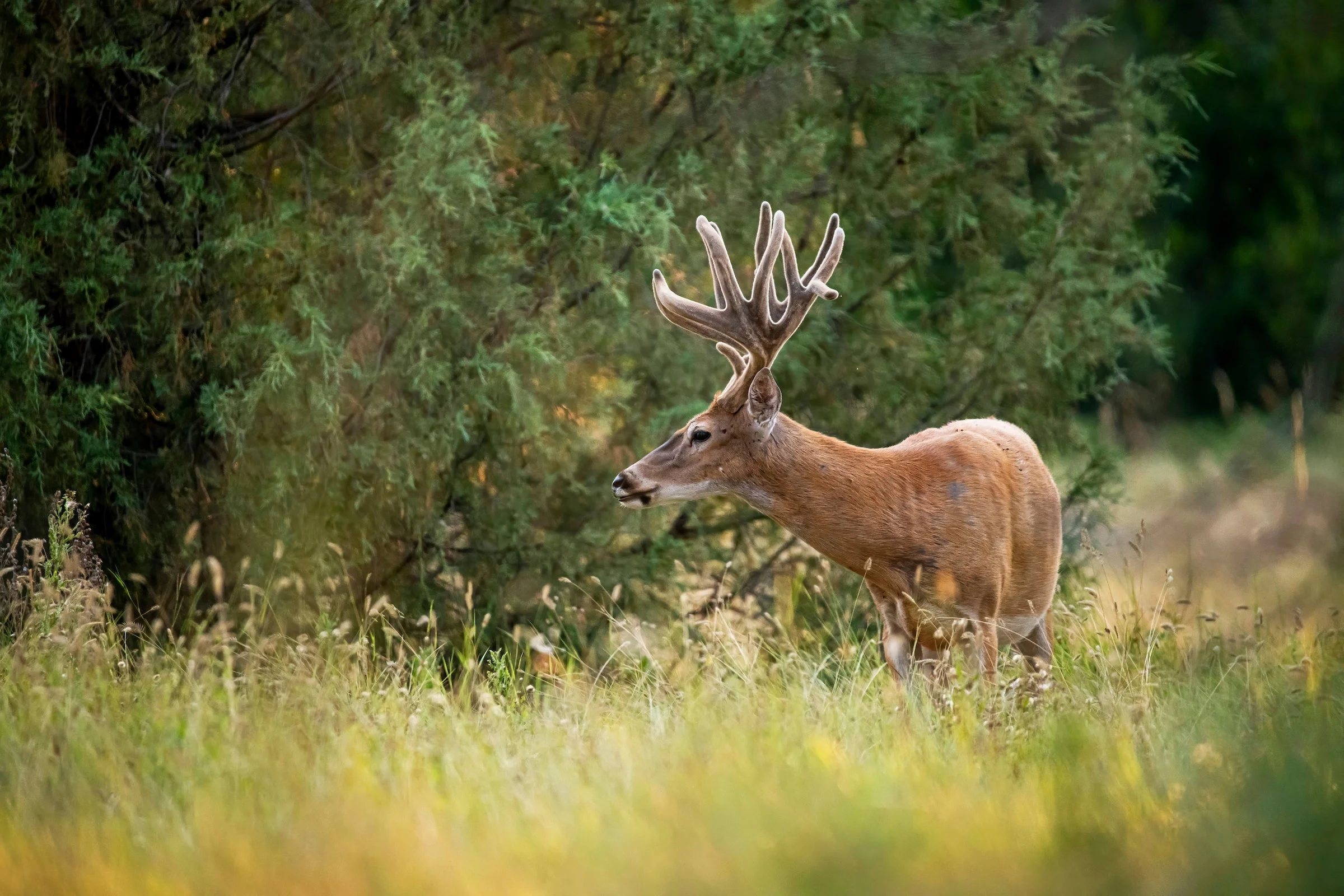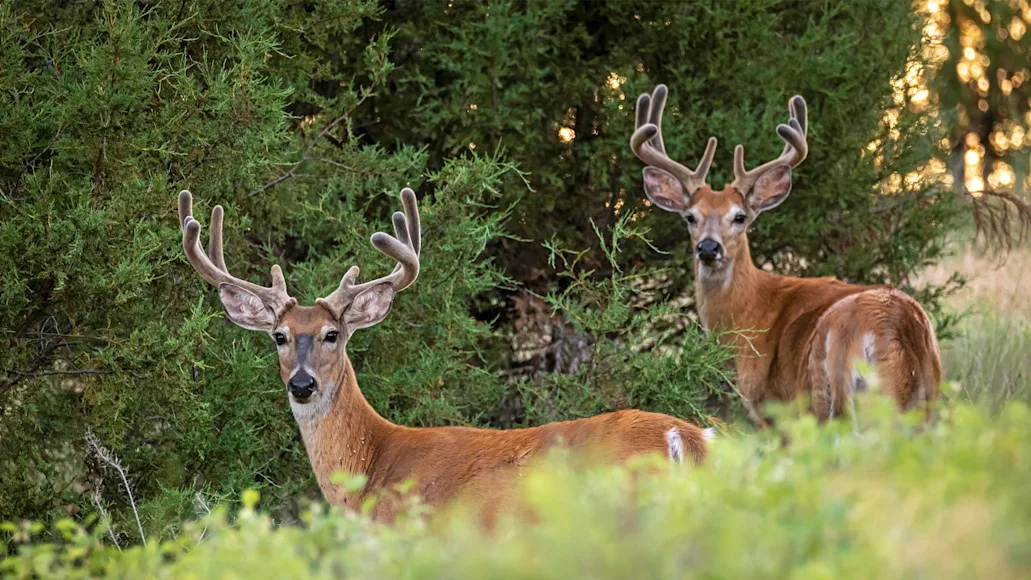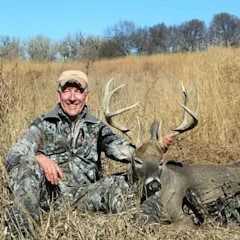_We may earn revenue from the products available on this page and participate in affiliate programs. Learn more ›
_
For most of us, July is a month reserved for fishing, grilling, and maybe the beach. Not Minnesota whitetail expert Bob Borowiak, who starts scouting around July 4th and continues until the season opener. While most successful deer hunters recognize the need for thorough scouting, many wait until just before the season opener to begin. Borowiak insists that his midsummer observation sessions are responsible for most of the big deer he tags during the archery season.
Most of us would do well to listen to Borowiak, a retired 76-year old hunter from Houston, Minnesota. Though he didn’t start bowhunting whitetails until he was in his mid-30s, the expert has more than 30 P&Y bucks to his credit. At least 10 of those bucks were taken in the first weeks of the archery season
and were the direct result of scouting that Borowiak did on summer evenings. Here’s a look at the preseason prep work of one of the most successful bowhunters I know.
Why Midsummer Observation Is So Important

Borowiak with just one of his many P&Y early-season trophies. Bob Borowiak
In a whitetail world obsessed with trail cameras, Borowiak’s scouting regimen relies on good old-fashioned personal observation; his favorite tactic is to glass fields and food plots from distant vantage points. “I’m lucky in that I’m retired and have more free time than most,” he says. “But I am out there almost every night starting around July 4th. The one farm I hunt I can actually set my spotting scope
up in my truck and park 500-600 yards away and glass fields. That’s plenty close enough to judge antlers, and the nice thing is, I’m parked right on a road edge and deer are used to the sounds of traffic, so the truck doesn’t bother them.”
On other properties that don’t have such convenient glassing setups, Borowiak hikes in and sets up in discreet locations that allow him to observe fields and food plots, but not be seen, heard, or smelled by deer. “It’s also important to consider how you’re going to get out of there at dusk without spooking deer, so I make sure I’m not set up too close to any food source where deer are going to be when it gets dark,” he said.
While most hunters are content to let trail cameras do their summer intel for them, Borowiak insists nothing beats personal observation. “Cameras are definitely a good tool and part of my scouting, but they are limited in their ability,” he says. “They only give a small glimpse of what’s happening out in a field, while I can get a big picture view with my spotting scope. For example, I’ve had years where I might have three or more mature bucks using the same field for their evening feeding. If all I had was a camera, I might get one or two of those bucks, and just for a narrow window of time, a snapshot. Glassing allows me to take a good long look and monitor the entire herd, not just the buck that steps in front of a camera.”
That extended observation allows Borowiak not only a long time to evaluate antlers, but also to assess personality. “When those bucks start shedding velvet, some of them are going to disperse, but some will stick around. The more dominant bucks–which you can tell easily from observing them, even in velvet, have a better chance of sticking around. At this point I’m not trying to nail down specific patterns of individual bucks; I’m just getting an idea of what’s out there and the general areas used by bucks.”
**Related: Best Spotting Scopes of 2024
**
Rethinking Early-Season Buck Patterns

Big bucks rarely repeat the same pattern day after day. It can take a little patience to dupe them. John Hafner Photography
While much has been said and written about patterning bucks—especially in the early season—Borowiak uses the term cautiously, even though he’s deadly at bagging early-season trophies. “I’ve killed a couple bucks that made repeat visits to the same area on a regular basis, but I’m convinced those cases are rare, especially with bucks 4 or 5 years old,” he said. “With older deer, it’s more realistic to expect that, if you see a buck in one spot one night, he might be back a week later. I shot a 160-class buck two years ago that we got a pic of, walking through a food plot in the morning, as he headed back to bed. I was convinced that he’d repeat that behavior, but I’d just have to wait him out. I finally shot him on the sixth morning.”
Rather than use the term “pattern”, Borowiak feels bucks have preferred areas within their home range that they use consistently, but not daily. “You hear people talk about finding a buck’s bed, and the picture they try to paint is there’s this one small area that a buck returns to for bedding each day,” he says. “I don’t believe that’s what happens. I think bucks have a general bedding area that contains several places where he feels safe and comfortable, and he uses whatever bed within that area appeals to him on a certain day. And the same goes for food; I may glass a buck feeding in soybeans one evening, and the next he’s on alfalfa and after two nights there he switches to some acorns that have fallen. That’s one advantage of glassing; because I can cover more ground, I can get a better big-picture view of how bucks are using an area.”
Typically, by the season opener, Borowiak has identified 2 to 4 bucks that he’d be happy to shoot and has started formulating a game plan for the area. “Since the territories of these bucks overlap, I’m rarely holding out for one deer,” he says. “Instead, I’m hunting an area that I know has several bucks and I’m happy to take the first one to show up. And because I know that these bucks are not on a daily ’pattern’ that brings them to the same spot each evening, I don’t worry if I don’t see a target buck on a given night. All I’m concerned with is getting out of the stand without spooking other deer. When conditions are right, I’ll return.” Borowiak is constantly monitoring wind direction to help him choose stand sites, and he’s a religious user of Ozonics units for scent control in his stands and box blinds.
**Related: Best Binoculars for 2024
**
Camera Support Does Help With Summer Scouting

A big summer buck visits a freshened scrape in a staging area just off a food source. Browning Trail Cameras
While long-range glassing is at the core of his scouting program, Borowiak does use cameras to provide additional information. “I do like wireless cameras
because they simply require less intrusion into a buck’s area once you have them set up,” he said. Some of his favorite camera setups are water sources in the timber (he installs water tubs on hardwood ridges, which become magnets for deer and all sorts of wildlife, including bears and bobcats). “Water is a huge draw in this country, and while I do get pics of good bucks in the summer on water, I don’t worry if I don’t. Doe family groups find these water holes in a hurry and return to them throughout the year. When the rut comes, the bucks won’t be far behind them.”
Other preferred setups are early-season food sources like soybeans, alfalfa, apples and white oak acorns. “I look for good food where there’s good fresh deer sign,” Borowiak says. “There’s a lot of food out there for deer this time of year, so I’m not expecting daily visits. Just that pic or two that confirms there’s a good buck in the area.” Such was the case with a buck he named “Big Louie”, a heavy-racked deer that showed up and posed for a single picture by an apple tree. “I hung a stand in a tree 30 yards away and hunted it several times when he never showed up,” Borowiak recalled. “Then one evening a pair of 2-½ year old bucks showed up at that apple. One didn’t stick around long and the other started acting nervous and looking behind him. When I looked that way I could see Big Louie’s rack heading my way and though he was walking cautiously he came right to that apple tree and I made the shot.”
Borowiak’s final favorite camera setup is near an early-season scrape. While many hunters associate scrapes only with rutting activity, savvy hunters like Borowiak know that deer visit scrapes year round and early fall is a peak activity time. “I don’t do a lot of mock scrapes because I’m really careful about spending too much time, and laying down human scent, in a spot that I know a big buck already likes,” he said. “But if I find a natural scrape, I’ll freshen it with some ‘Scrape Fix’ by TactaCam, which I apply to the overhanging branch and also on the ground. Then I hang my camera and get out of there.”
As noted, Borowiak took up bowhunting relatively late in life. Though he’d been a successful gun hunter for mature bucks, he definitely struggled after becoming a bowhunter. “I spent the first 8 years hunting deer that didn’t exist,” he laughs. “I was basically hunting the landscape or setting up on some fresh sign and hoping that a big buck would appear. But I had zero evidence that they were even in the neighborhood. That all changed when I started putting in my time, doing the long-range glassing and really trying to get a handle on what deer are out there and what they’re doing, long before the season even started. It’s made a huge difference.”
And while Borowiak’s summer observations have led him to some dandy bucks taken in the first weeks of the season, he’s convinced that his summer scouting efforts pay off as the fall progresses. “Not all the bucks I spot in the summer will be in spots I can hunt at the opener,” he says. “But I know they’re in the immediate area and might be huntable later. Just knowing what’s out there gives me so much confidence and enthusiasm. Almost every Minnesota buck I’ve killed, regardless of the time frame, is a deer I knew from my scouting and observations.”
**Read Next: Best Cellular Trail Cameras for 2024
**


